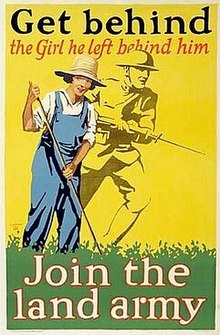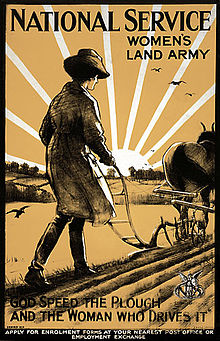Women's Land Army (World War I)


The Women's Land Army (WLA) was a British civilian organisation. It was created in 1917 by the Board of Agriculture during World War I to encourage women to work in agriculture, replacing men called up to the military. Women who worked for the WLA were commonly known as Land Girls. In effect the Land Army operated to place women with farms that needed workers, the farmers being their employers. They picked crops and did all the jobs that the men would do. Notable members included the archaeologist Lily Chitty and the botanist Ethel Thomas. It was disbanded in 1919 but revived in June 1939 under the same name.
History[]
The Women's Farm and Garden Union had existed since 1899[1] and in February 1916 they sent a deputation to meet Lord Selborne. Selborne's Ministry of Agriculture agreed to fund a Women’s National Land Service Corps with a grant of £150.[2] Louise Wilkins was to lead the new organisation[3] that was to focus on recruiting women for emergency war work. They were tasked with improving recruitment and provide propaganda about the good cause of women of all classes undertaking agricultural work.[2] The new members of the organisation were to not become agricultural workers but to organise others (eg in villages) to do this work. By the end of 1916 they had recruited 2,000 volunteers, but they estimated that 40,000 was required.[2] At the Women’s National Land Service Corps's suggestion a Land Army was formed. The WNLSC continued to deal with recruitment and[4] the network assisted in the launch of a "Land Army" and by April 2017 they had over 500 replies and 88 joined the new Land Army where they became group leaders and supervisors.[2]

In time the Land Army would take on 23,000 workers who took the place of the 100,000 workers lost to the forces. The women were paid 18 shillings a week and this could be increased to 20 shillings (a pound) if they were considered efficient. 23,000 was a significant contribution, but there were estimated to be 300,000 women working on the land during the first world war.[5]

A Good Service Ribbon was awarded to eligible women.[6] January 1918 saw the publication of the first issue of The Landswoman, the official monthly magazine of the Women’s Land Army and the Women’s Institutes.[7] The organisation was disbanded in November 1919.[8]
Commemoration[]
In October 2012, the Prince of Wales unveiled the first memorial to the WLA of both World Wars, on the Fochabers estate in Moray, Scotland. The sculpture was designed by Peter Naylor.[9] In October 2014, a memorial statue to the Women's Timber Corps and both incarnations of the Women's Land Army was unveiled at the National Memorial Arboretum in Staffordshire, England.[10]
See also[]
- Category:Women's Land Army members (World War I)
- Canary girls
- Women's Royal Air Force (World War I)
- Women's Emergency Corps
- Victory garden
- Women's Defence Relief Corps
Further reading[]
- Kramer, Ann. Land Girls and their Impact, Remember When (2008), ISBN 978-1-84468-029-0.
- Twinch, Carol. Women on the Land: Their story during two world wars, Lutterworth Press (1990), ISBN 978-0-7188-2814-1.
References[]
- ^ "History – WFGA". Retrieved 2021-04-07.
- ^ a b c d "WW1 Women Land Worker Organisations". Women's Land Army.co.uk. Retrieved 2021-04-07.
- ^ "Wilkins [née Jebb], Louisa (1873–1929), agricultural administrator". Oxford Dictionary of National Biography. doi:10.1093/ref:odnb/50178. Retrieved 2021-04-07.
- ^ "brassard, British, Women's National Land Service Corps". Imperial War Museums. Retrieved 2021-04-07.
- ^ "Formation". Women's Land Army.co.uk. Retrieved 2021-04-08.
- ^ 97 years ago today: Presentation of Good Service Ribbons in Stafford, 1919
- ^ "The Landswoman Magazine (WW1)". The Women’s Land Army. Cherish Watton. Retrieved 12 October 2018.
- ^ 'Women's Land Army', Sheffield Daily Telegraph, 6 October 1919, page
- ^ "The Prince of Wales unveils memorial to Women's Land Army". Prince of Wales. Retrieved 2 March 2017.
- ^ "Memorial Arboretum Land Girls monument unveiled after three-year fundraising campaign". BBC News.
External links[]
| Wikimedia Commons has media related to British Women's Land Army in World War I. |
- British women in World War I
- United Kingdom in World War I
- Agricultural organisations based in the United Kingdom
- Women's organisations based in the United Kingdom
- History of agriculture in the United Kingdom
- Organizations established in 1915
- Organizations disestablished in 1915
- 1915 establishments in the United Kingdom
- 1919 disestablishments in the United Kingdom
- Women's Land Army members (World War I)